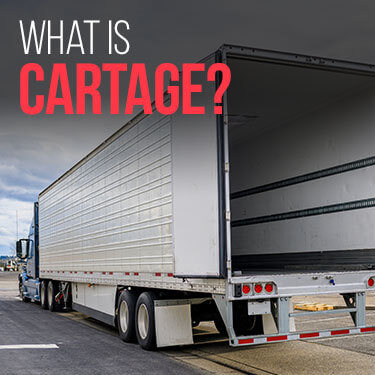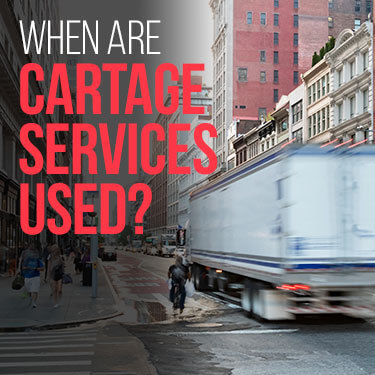Cartage service is just one of many options that shippers use in the transportation industry. Cartage is a specialized and particularly common service that is used by shippers to deliver goods to businesses and residences. But what exactly is cartage service?
Shippers use cartage services when they need to ship their freight short distances within a metropolitan area or small town. This type of freight shipping service transports freight as LTL shipments. Freight that is transported using cartage is delivered by truck or van rather than in a dry van trailer like most freight.
Cartage is a unique freight shipping service but it's often confused with other freight-related terms. In this article, we will explain how to utilize cartage services and highlight the key similarities and differences it has with other freight services.

Cartage is the process of moving goods over short distances. Goods that are transported with this service could travel within a metropolitan area or a small town.
Most carriers don't offer cartage services because they focus on long-distance shipping. As a result, many customers opt to find cartage agents that will transport their light haul shipment of goods the short distances carriers won't cover.
Cartage companies use delivery trucks or vans to transport their customer's goods as LTL or less than truckload shipments. Therefore, many cartage companies charge shippers that utilize their services a cartage fee. This is similar to the fee that customs brokers, warehousing and shipping agents would charge for their services.
To utilize cartage services, there are about three steps that you will have to follow:
First, you will need to find and contact a cartage agent. Then your shipment will have to be handed off to the cartage company. If your shipment is handed off by a carrier, it will be marked as "delivered" by the carrier and can't be tracked with that carrier any further.
Next, you will have to fill out new paperwork with your cartage agent since the paperwork that you used with your original carrier won't carry over.
The document that shippers have to use for cartage services is called cartage advice. This legal document is similar to a bill of lading (BOL). The cartage advice document contains critical information about your shipment regarding things like destination, quantity of goods and the type of goods being moved.

Cartage fees will be charged by your cartage company or truck driver performing the cartage services for you. Typically, the cartage fees will be quoted on the freight invoice for your shipment.
Oftentimes cartage fees are applied when a truck transports goods a short distance to a certain location like a residential area or business. However, there are other instances where cartage is used to transport freight from free trade zones and into a port.
Free trade zones are geographic areas where various kinds of goods are welcome. Free trade zones are often extremely close to ports where goods are imported and exported by cargo vessels.
Goods that are in free trade zones can be taken to a port for loading and then be re-exported. Cartage services come in handy for scenarios like this because the goods only need to travel a short distance to the port they will be re-exported from.
Probably the most common and obvious form of cartage service is the one that transports goods within a city or small town. Since destinations are so close together in areas like these, it doesn't make sense to pay for the services of a normal long-haul shipment.
Instead, cartage companies will take on this responsibility using their small trucks and vans to transport shipments within these more compact areas.
Even though cartage is a unique service it has much in common with other types of ground transportation services. Cartage has so much in common with other transportation services that it's sometimes used interchangeably with services like drayage or haulage.
Since there is so much confusion between cartage and other transportation services, it’s important to understand how cartage is both similar and different from these services.
Some of the services that cartage gets confused with are:

Cartage and drayage services have many things in common. For one, both services transport freight fairly small distances. In the case of drayage services, freight is transported no further than 250 miles from the port it’s received at.
The difference between the two services lies in where the freight is transported. Freight that is transported using drayage services is typically delivered in a cargo container to a warehouse or distribution center. Once the container arrives, the freight in the containers is dispersed into smaller shipments.
Cartage services, on the other hand, transport bulk shipments and shipments that have already been dispersed into smaller ones. Smaller shipments are transported to destinations in cities or metropolitan areas. Another difference between these two services is what the freight is transported in.
Drayage services transport freight within a cargo container while cartage services transport freight within either a truck or a van.
For more information about these two services, consult our complete overview on drayage vs cartage.
Cartage and haulage are two services that have more differences than they do similarities. Rather than use trucks or vans, haulage services transport freight in shipping containers either by truck or using a railway.
Haulage services, like cartage, transport freight over short distances but can also transport freight over long distances. There are also two different types of haulage services which are carrier haulage and merchant haulage.
Shunting is a type of service that has much more in common with cartage than the other two services. Both shunting and cartage services are transportation services that cover short distances. While cartage deals with moving freight over short distances, shunting focuses more on moving containers over a short distance.
Containers can either be empty or they can be loaded to the brim with freight. Cartage services will transport freight to areas within cities and towns. Shunting, however, moves containers short distances within the port area.
The table below sums up the differences and similarities between all four functions.
| Distance | Mode of Transportation | Destination | |
| Cartage | Short | Delivery Truck or Van | Destinations in a city or town |
| Drayage | Short | Chassis Carrying A Container | Warehouse or distribution center |
| Haulage | Short and Long | Chassis Carrying A Container | Warehouse or Distribution Center |
| Shunting | Short | Chassis Carrying A Container | Different locations in the port yard |
If you need to get your bulk shipment to a cartage freight company, R+L Global Logistics is the company you need. We have experience in providing shippers with carriers that can transport their bulk shipment of products.
From heavy haul to hazmat and flatbed shipping, R+L Global Logistics has relationships with various carriers that offer these types of services. Our team at R+L Global Logistics can provide you with the carrier you need.
Start your relationship with R+L Global Logistics by filling out your quote located on our truckload page.
R+L Global Logistics
315 NE 14th St., Ocala, FL 34470